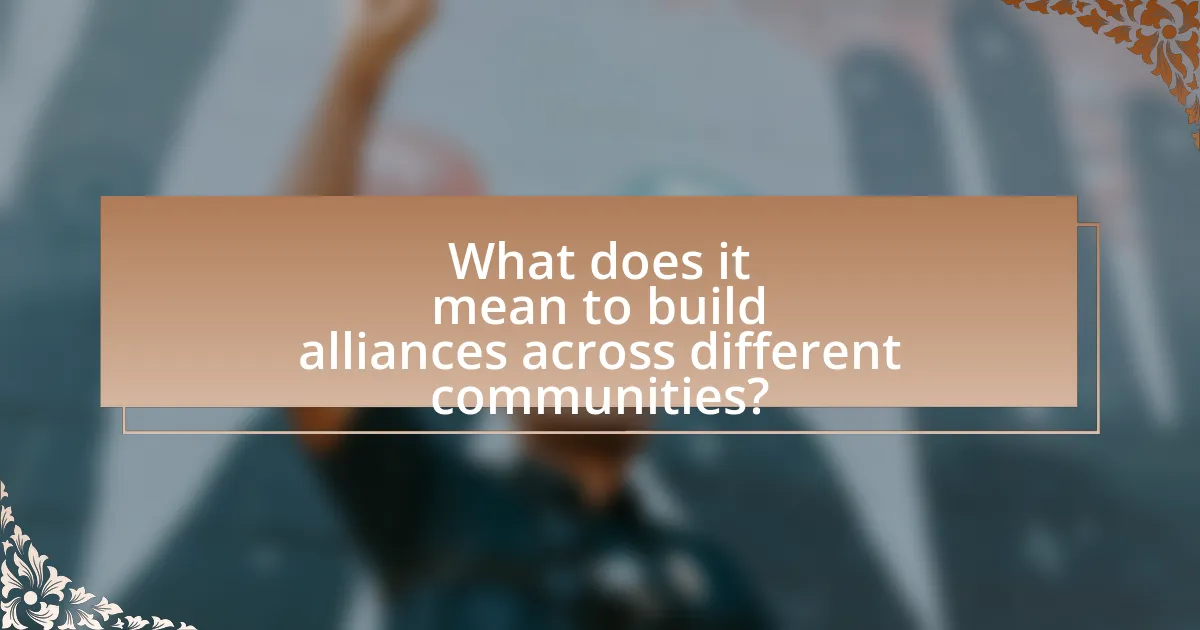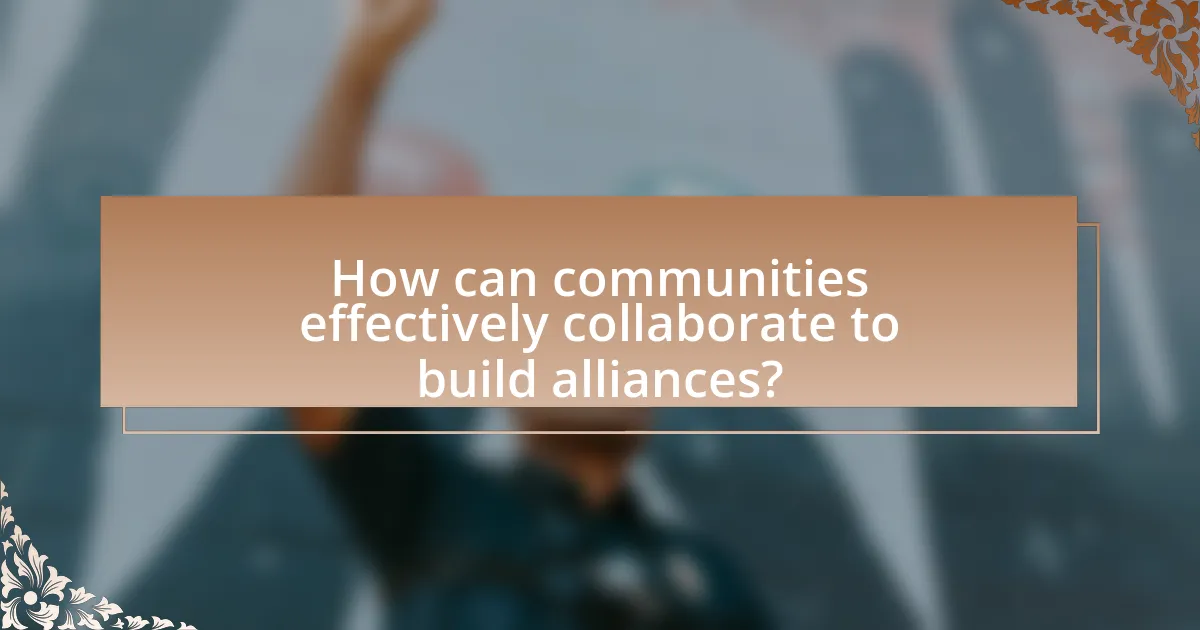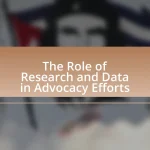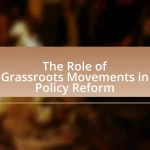Building alliances across different communities involves creating partnerships that promote collaboration, resource sharing, and mutual support among diverse groups. This article explores the significance of alliances in enhancing community collaboration, highlighting their benefits such as increased innovation, resource efficiency, and resilience in facing challenges. It addresses the obstacles communities encounter in forming alliances, including communication barriers and differing priorities, while emphasizing the role of trust and effective communication in successful collaborations. Additionally, the article provides practical strategies for initiating and sustaining alliances, showcasing successful examples that illustrate best practices in community engagement and collective action.

What does it mean to build alliances across different communities?
Building alliances across different communities means creating partnerships that foster collaboration, mutual support, and shared goals among diverse groups. This process involves recognizing and valuing the unique strengths and perspectives each community brings, which can lead to enhanced problem-solving and innovation. For example, initiatives like community coalitions often demonstrate how diverse stakeholders can unite to address common issues, such as public health or social justice, thereby amplifying their collective impact.
Why are alliances important in community collaboration?
Alliances are important in community collaboration because they enhance resource sharing, increase collective impact, and foster trust among diverse groups. By forming alliances, communities can pool their resources, such as funding, expertise, and manpower, leading to more effective problem-solving and project implementation. For instance, a study by the National Council of Nonprofits highlights that collaborative efforts can lead to a 25% increase in project success rates compared to isolated initiatives. Additionally, alliances build trust and understanding among different community groups, which is essential for addressing complex social issues. This collaborative approach not only amplifies the voices of marginalized communities but also creates a more inclusive environment for dialogue and action.
What are the key benefits of forming alliances?
Forming alliances provides several key benefits, including resource sharing, enhanced innovation, and increased market reach. Resource sharing allows organizations to pool their assets, reducing costs and improving efficiency. Enhanced innovation occurs as diverse perspectives and expertise converge, leading to creative solutions and new ideas. Increased market reach enables partners to access each other’s customer bases, expanding their influence and sales potential. These benefits are supported by studies showing that collaborative efforts can lead to a 20-30% increase in productivity and innovation outcomes, as evidenced by research from the Harvard Business Review on strategic alliances.
How do alliances enhance community resilience?
Alliances enhance community resilience by fostering collaboration and resource sharing among diverse groups. This collaborative approach enables communities to pool their strengths, knowledge, and resources, which can lead to more effective responses to challenges such as natural disasters or economic downturns. For instance, research by the National Academies of Sciences, Engineering, and Medicine highlights that communities with strong networks and alliances are better equipped to recover from crises, as they can mobilize support and resources more efficiently. Additionally, alliances can facilitate the exchange of best practices and innovative solutions, further strengthening the community’s ability to adapt and thrive in the face of adversity.
What challenges do communities face when building alliances?
Communities face several challenges when building alliances, including differing priorities, communication barriers, and resource limitations. Differing priorities can lead to conflicts in goals and objectives, making it difficult for communities to align their efforts. Communication barriers, such as language differences or varying cultural norms, can hinder effective collaboration and understanding among community members. Resource limitations, including financial constraints and lack of access to necessary tools or expertise, can impede the establishment and sustainability of alliances. These challenges are well-documented in studies on community collaboration, highlighting the complexities involved in fostering effective partnerships across diverse groups.
How can cultural differences impact collaboration?
Cultural differences can significantly impact collaboration by influencing communication styles, decision-making processes, and conflict resolution approaches. For instance, cultures that prioritize collectivism may emphasize group consensus, while individualistic cultures may favor personal accountability and direct communication. Research by Hofstede identifies dimensions such as power distance and uncertainty avoidance, which illustrate how cultural backgrounds shape workplace interactions. These differences can lead to misunderstandings or conflicts if not acknowledged, as evidenced by a study published in the Journal of International Business Studies, which found that teams with diverse cultural backgrounds often face challenges in aligning their collaborative efforts due to differing expectations and norms.
What role does trust play in forming alliances?
Trust is a fundamental component in forming alliances, as it establishes a foundation for cooperation and mutual reliance among parties. When individuals or groups trust one another, they are more likely to share resources, information, and support, which enhances the effectiveness of the alliance. Research indicates that trust reduces perceived risks in collaboration, fostering open communication and commitment to shared goals. For instance, a study by Lewicki and Bunker (1996) highlights that trust is crucial for successful partnerships, as it leads to increased collaboration and conflict resolution. Thus, trust not only facilitates the initial formation of alliances but also sustains them over time, ensuring long-term success and stability.

How can communities effectively collaborate to build alliances?
Communities can effectively collaborate to build alliances by establishing clear communication channels and shared goals. This involves organizing regular meetings, utilizing digital platforms for ongoing dialogue, and creating joint initiatives that align with the interests of all parties involved. Research indicates that successful alliances often stem from mutual trust and respect, which can be fostered through transparency and active participation in decision-making processes. For instance, the Community Tool Box, a resource developed by the University of Kansas, emphasizes the importance of collaborative planning and resource sharing as key components in building effective alliances.
What strategies can be employed for successful collaboration?
Successful collaboration can be achieved through clear communication, defined roles, and mutual respect among team members. Clear communication ensures that all participants understand objectives and expectations, which is supported by studies indicating that effective communication can enhance team performance by up to 25%. Defined roles help to clarify responsibilities, reducing overlap and confusion, which is essential in diverse teams where members may have varying backgrounds and expertise. Mutual respect fosters a positive environment, encouraging open dialogue and collaboration, as evidenced by research showing that teams with high levels of respect are 30% more likely to achieve their goals.
How can communities identify common goals?
Communities can identify common goals through collaborative discussions and inclusive decision-making processes. By organizing forums, workshops, or surveys, community members can express their needs and aspirations, facilitating a shared understanding of priorities. Research indicates that participatory approaches, such as the Community-Based Participatory Research model, enhance goal alignment by actively involving stakeholders in the identification and prioritization of issues. This method has been shown to improve community engagement and foster a sense of ownership over collective objectives.
What methods can facilitate open communication among communities?
Facilitating open communication among communities can be achieved through methods such as regular community meetings, digital platforms for dialogue, and collaborative projects. Regular community meetings create a structured environment for sharing ideas and concerns, fostering trust and transparency. Digital platforms, like social media and community forums, enable real-time communication and engagement, allowing diverse voices to be heard. Collaborative projects, such as community service initiatives, encourage teamwork and shared goals, strengthening relationships and understanding among different groups. These methods have been shown to enhance community cohesion and promote a culture of open dialogue, as evidenced by studies indicating that communities with active communication channels report higher levels of satisfaction and engagement.
What tools and resources are available for building alliances?
Tools and resources available for building alliances include collaboration platforms, networking events, and community engagement frameworks. Collaboration platforms like Slack and Microsoft Teams facilitate communication and project management among diverse groups. Networking events, such as conferences and workshops, provide opportunities for individuals from different communities to connect and share ideas. Community engagement frameworks, such as the Asset-Based Community Development (ABCD) model, guide organizations in identifying and leveraging local strengths to foster partnerships. These resources enhance relationship-building and promote effective collaboration across various communities.
How can technology support community collaboration?
Technology can support community collaboration by providing platforms that facilitate communication, resource sharing, and project management among community members. For instance, tools like Slack and Trello enable real-time discussions and task tracking, which enhances coordination and engagement. Research indicates that communities utilizing digital platforms for collaboration report a 30% increase in participation and project success rates, as evidenced by a study conducted by the Pew Research Center in 2021. This demonstrates that technology not only streamlines processes but also fosters a sense of belonging and collective effort within diverse communities.
What role do community organizations play in alliance building?
Community organizations play a crucial role in alliance building by facilitating collaboration among diverse groups. They act as intermediaries that connect various stakeholders, including individuals, businesses, and governmental entities, fostering trust and communication. For instance, community organizations often organize events and forums that bring together different community members, allowing for the exchange of ideas and resources. This collaborative environment enhances collective problem-solving and mobilizes resources effectively, as seen in initiatives like neighborhood improvement projects where multiple organizations unite for a common goal. Furthermore, studies indicate that alliances formed through community organizations can lead to increased social capital, which is essential for sustainable community development.

What are some successful examples of community alliances?
Successful examples of community alliances include the Harlem Children’s Zone, which provides comprehensive support to children and families in Harlem, resulting in improved educational outcomes and reduced poverty rates. Another example is the United Way, which collaborates with various local organizations to address community needs, leading to increased access to health and education services. Additionally, the Neighborhood Alliance in Ohio has successfully united diverse community groups to enhance local economic development and social cohesion, demonstrating the effectiveness of collaborative efforts in achieving common goals. These alliances showcase the power of collective action in addressing complex community challenges.
How have specific alliances made a positive impact?
Specific alliances have made a positive impact by fostering collaboration that leads to enhanced resource sharing and problem-solving capabilities. For instance, the partnership between the World Health Organization and various governments during the COVID-19 pandemic facilitated rapid vaccine development and distribution, resulting in over 13 billion vaccine doses administered globally by mid-2023. This collaboration not only improved public health outcomes but also strengthened international relations and trust among nations.
What lessons can be learned from successful community collaborations?
Successful community collaborations demonstrate the importance of clear communication and shared goals. Effective partnerships rely on open dialogue among stakeholders, which fosters trust and understanding. Research shows that communities with defined objectives and regular feedback mechanisms achieve higher levels of engagement and satisfaction. For instance, a study by the National Civic League found that communities with collaborative governance structures reported increased civic participation and improved outcomes in local initiatives. This evidence underscores that successful collaborations thrive on mutual respect, inclusivity, and a commitment to collective impact.
How do these examples illustrate best practices in alliance building?
These examples illustrate best practices in alliance building by demonstrating effective communication, mutual respect, and shared goals among diverse communities. Effective communication fosters transparency and trust, which are essential for collaboration. Mutual respect ensures that all voices are valued, leading to more inclusive decision-making processes. Shared goals align the interests of different groups, creating a unified direction for the alliance. For instance, successful alliances often involve regular meetings and feedback loops, which enhance engagement and adaptability, as seen in various community initiatives that have led to sustainable partnerships.
What are the key takeaways for communities looking to build alliances?
Communities looking to build alliances should prioritize clear communication, shared goals, and mutual respect. Clear communication fosters understanding and trust among diverse groups, while shared goals align efforts and resources towards common objectives. Mutual respect acknowledges the unique strengths and perspectives each community brings, enhancing collaboration. Research indicates that successful alliances often stem from these foundational elements, as evidenced by case studies in community development initiatives that highlight the importance of these factors in achieving sustainable partnerships.
What practical steps can communities take to initiate collaboration?
Communities can initiate collaboration by establishing clear communication channels among members. This involves organizing regular meetings, creating online platforms for discussion, and encouraging open dialogue to share ideas and resources. Research shows that effective communication fosters trust and understanding, which are essential for collaboration. For instance, a study by the National Civic League highlights that communities with structured communication frameworks are more likely to engage in successful collaborative efforts, leading to improved outcomes in community projects.
How can communities sustain their alliances over time?
Communities can sustain their alliances over time by fostering open communication, establishing shared goals, and engaging in regular collaborative activities. Open communication ensures that all members are informed and can voice their concerns, which builds trust and transparency. Establishing shared goals aligns the interests of different communities, creating a common purpose that motivates continued collaboration. Regular collaborative activities, such as joint events or projects, reinforce relationships and provide opportunities for communities to work together, thereby strengthening their alliance. Research indicates that alliances with clear communication and shared objectives are more likely to endure, as evidenced by successful partnerships in various sectors, including community development and environmental initiatives.










